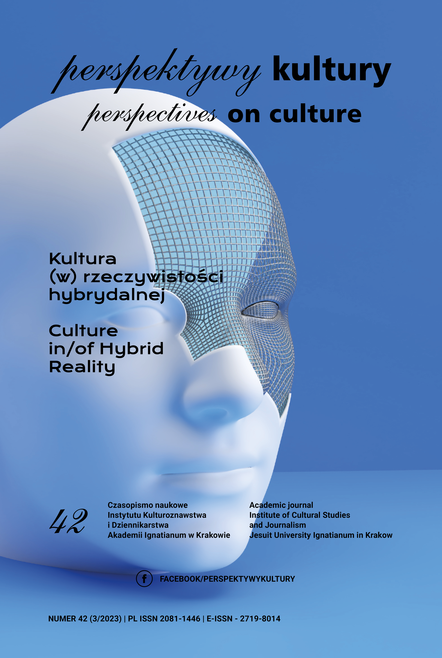Paradoksy podróży w czasie w kinie Juliusza Machulskiego
Abstrakt
Tematyka podróży w czasie nie cieszy się zbytnią popularnością w kinie polskim. Filmy Ile waży koń trojański? (2008) i AmbaSSada (2013) w reżyserii Juliusza Machulskiego, wnikliwego obserwatora i ostrego krytyka polskiej rzeczywistości społeczno-politycznej, są rzadkimi wyjątkami. Znany z kina komediowego lat 80., obnażającego absurdy reżimu komunistycznego w Polsce, Machulski zabiera widzów w podróż w czasie w dwóch postmilenijnych produkcjach z pogranicza fantasy i science fiction. Ile waży koń trojański? przenosi widzów w czasy późnego PRL-u, a AmbaSSada – do roku 1939 w przeddzień wybuchu II wojny światowej. Celem tego artykułu jest analiza zjawiska podróży w czasie, jego paradoksów i konsekwencji, jak również natury diegetycznej rzeczywistości ukazanej w filmach Juliusza Machulskiego.
Bibliografia
Al-Khalili, J. (2003). Black Holes, Wormholes and Time Machines. Bristol: Institute of Physics Publishing.
Bould, M., Butler, A.M., Roberts, A., & Vint, S. (eds.). (2009). The Routledge Companion to Science Fiction. New York: Routledge.
Frey, D. (2021). The Four Types of Time Travel (And What They Say About Ourselves and the World Around Us). Retrieved from: https://crimereads.com/the-four-types-of-time-travel-and-what-they-say-about-ourselves-and-the-world-around-us/ (access: 22.10.2022).
Gleick, J. (2017). Time Travel: A History. London: Harper Collins Publish-ers.
Koberlein, B. (2015). Why It’s Impossible To Go Back In Time And Kill Baby Hitler. Retrieved from: https://www.forbes.com/sites/briankoberlein/2015/10/23/why-its-impossible-to-go-back-in-time-and-kill-baby-hitler/?sh=179622329c02 (access: 22.10. 2022).
Majer, A. (2014). Kino Juliusza Machulskiego. Bielsko-Biała: Wydawnictwo Kwieciński.
Meslow, S. (2012). A Brief history of Time Travel (In Movies). Retrieved from: https://www.theatlantic.com/entertainment/archive/2012/05/a-brief-history-of-time-travel-in-movies/257638/#:~:text=The%20first%20three%20notable%20entries,talkie%2C%20and%20a%201949%20musical (access: 22.10.2022).
Olczak-Moraczewska, H. (2009). Juliusz Machulski. Retrieved from: https://culture.pl/en/tworca/juliusz-machulski (access: 22.10.2022).
Petruzzello, M. (ed). Predestination. Encyclopedia Britannica. Retrieved from: https://www.britannica.com/topic/predestination (access: 22.10.2022).
Rafferty, J.P. (ed). Edward Lorenz. Encyclopedia Britannica. Retrieved from: https://www.britannica.com/biography/Edward-Lorenz (access: 22.10.2022).
Sherman, F.A. (2017). Now and Then We Travel. Visiting Pasts and Futures in Film and Television. Jefferson, North Carolina: McFarland & Com-pany Inc. Publishers.
St. James, E. (2016). ‘Back to the Future’ is the most perfect blockbuster ever made. I will not hear otherwise. Retrieved from: https://www.vox.com/2015/7/1/8876073/back-to-the-future-anniversary-30 (access: 22.10.2022).
Wasserman, R. (2018). Paradoxes of Time Travel. Oxford: Oxford Univer-sity Press.
Filmography
A Connecticut Yankee in King Arthur’s Court, dir. Emmett J. Flynn, USA: Fox Film, 1921.
A Connecticut Yankee in King Arthur’s Court, dir. David Butler, USA: Fox Film Corporation, 1931.
A Connecticut Yankee in King Arthur’s Court, dir. Tay Garnett, USA: Par-amount Pictures, 1949.
Back to the Future, dir. Robert Zemeckis, USA: Universal Pictures, 1985.
Back to the Future Part II, dir. Robert Zemeckis, USA: Universal Pictures, 1989.
Back to the Future Part III, dir. Robert Zemeckis, USA: Universal Pictures, 1990.
EmbaSSy (AmbaSSada), dir. Juliusz Machulski, Poland: Studio Filmowe Zebra, 2013.
Groundhog Day, dir. Harold Ramis, USA: Columbia Pictures, 1993.
Hour Of The Crimson Rose (Godzina pąsowej róży), dir. Halina Bielińska, Poland: Wytwórnia Filmów Fabularnych, 1963.
How Much Does The Trojan Horse Weigh? (Ile waży koń trojański?), dir. Juliusz Machulski, Poland: Studio Filmowe Zebra, 2008.
Kiler, dir. Juliusz Machulski, Poland: Studio Filmowe Zebra, 1997.
Midnight in Paris, dir. Woody Allen, USA: Sony Pictures Classics, 2011.
Sexmission (Seksmisja), dir. Juliusz Machulski, Poland: Zespół Filmowy Kadr, 1984.
Superproduction (Superprodukcja), dir. Juliusz Machulski, Poland: Studio Filmowe Zebra/Vision Film, 2003.
The Adam Project, dir. Shawn Levy, USA: Netflix, 2022.
The Hourglass Sanatorium (Sanatorium pod klepsydrą), dir. Wojciech Jerzy Has, Poland: Zespół Filmowy Silesia, 1973.
The Lullaby (Kołysanka), dir. Juliusz Machulski, Poland: Studio Filmowe Zebra, 2010.
The Time Machine, dir. George Pal, USA: Metro-Goldwyn-Mayer/Galaxy Films, 1960.
The Time Machine, dir. Simon Wells, USA: Warner Bros., 2002.
Vabank, dir. Juliusz Machulski, Poland: Zespół Filmowy Kadr, 1981.
Vinci, dir. Juliusz Machulski, Poland: Studio Filmowe Zebra, 2004.
Copyright (c) 2022 Perspektywy Kultury

Utwór dostępny jest na licencji Creative Commons Uznanie autorstwa – Bez utworów zależnych 4.0 Międzynarodowe.
Autor, zgłaszając swój artykuł, wyraża zgodę na korzystanie przez Wydawnictwo Uniwersystet Ignatianum z utworu na następujących polach eksploatacji:
- utrwalania utworu w formie papierowej, a także na nośniku cyfrowym lub magnetycznym;
- zwielokrotnienia utworu dowolną techniką, bez ograniczenia ilości wydań i liczby egzemplarzy;
- rozpowszechniania utworu i jego zwielokrotnionych egzemplarzy na jakimkolwiek nośniku, w tym wprowadzenia do obrotu, sprzedaży, użyczenia, najmu;
- wprowadzenia utworu do pamięci komputera;
- rozpowszechniania utworu w sieciach informatycznych, w tym w sieci Internet;
- publicznego wykonania, wystawienia, wyświetlenia, odtworzenia oraz nadawania i reemitowania, a także publicznego udostępniania utworu w taki sposób, aby każdy mógł mieć do niego dostęp w miejscu i czasie przez siebie wybranym.
Wydawca zobowiązuje się szanować osobiste prawa autorskie do utworu.





